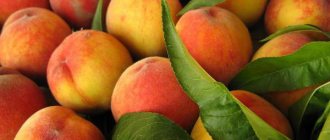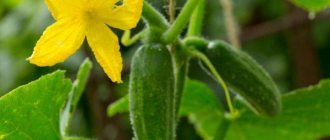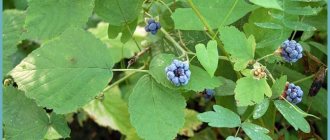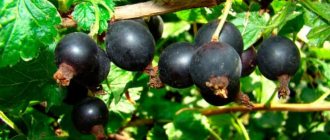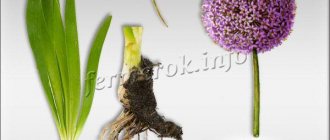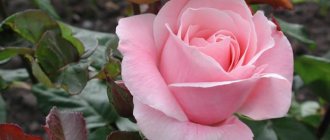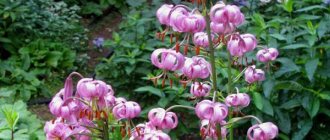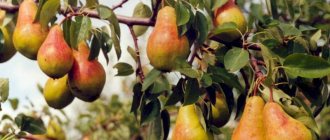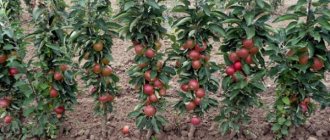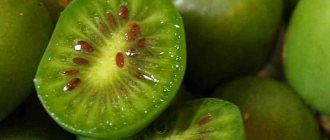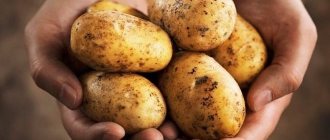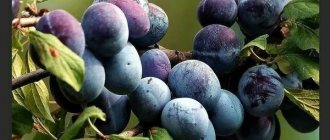for the Urals and Siberia
Plum is a non-traditional crop for the Urals and Siberia.
Its wild relatives are practically not found in natural landscapes. The assortment that has appeared is the result of a very long and painstaking selection work of scientists. One plum breeding center is located at the South Ural Research Institute of Fruit and Vegetable Growing (Chelyabinsk). Another center of work has developed at the stronghold of the Scientific Research Institute of Horticulture of Siberia in the mountains. Chemal, Gorno-Altai region. Our review presents new varieties from these institutes, as well as the best varieties of folk selection from the Far East. All these varieties are derived from the most cold-resistant Ussuri plum in the world, which can tolerate frosts down to minus 50°C.[/td]
| When to harvest in the garden - https://fas.st/dUzHUW» target=»_blank»> |
Landing rules
The Siberian climate is quite complex and harsh. When planting any trees and shrubs in this region, you should carefully select the plant variety. An incorrectly selected variety will not be able to cope with unpredictable weather conditions, and you will not get a harvest. What problems may gardeners in the Urals and Siberia encounter when growing plums?
- Damping off of parts of wood. Such winter damage to trees can be encountered quite often in this region. The tree bark dies. Almost the entire tree or its individual parts may be affected. This happens due to the fact that the tree was exposed to zero temperatures for a long time, while being under a thick layer of snow. This happens especially often when snow falls unexpectedly early, and the ground has not yet had time to freeze. Damping off is one of the most serious problems that can completely destroy a tree. You can notice this process by the brown bark at the bottom of the tree or at the bottom of the shoots. The plum may even bloom, but then the withered shoots die off.
- Freezing of plums. Freezing of a tree is considered a less dangerous problem, compared to damping off of its parts, for gardeners in the Urals. After freezing, a tree can always recover. This process always starts from the top of the tree. You can tell about the problem by the darkened bark. Frozen shoots do not bloom, but can later recover.
- Avoid areas with groundwater too close to the ground surface. Although plums love moist soils, they do not tolerate excessive moisture. In addition, groundwater in winter can cause roots to freeze in winter. They must flow deeper than 1.5 m from the surface of the earth;
- The planting area should be well lit. Plum is still more of a southern plant;
- The planting site should not be in a too windy place. To protect from the cold north wind on this side of the plum tree, it is advisable to plant larger plants that will serve as a barrier;
- You should not choose plums and low-lying areas for planting, where cold and damp air always stagnates;
- choose an area for planting with easy access to it. Firstly, this is necessary so that you can safely carry out all plum care procedures, including pruning, fertilizing, watering, etc. Secondly, the root system must have enough space for growth and development. If you plant several trees in a row, then maintain a minimum distance of 3 m;
- If the area on your site is hilly, then plant the plum tree at the top of the hill.
Plum is a fruit tree that is quite selective in its planting location. You should adhere to the following recommendations:
Plum is also demanding on the soil, as well as on the place for planting. Experienced gardeners in the Urals recommend taking into account the following plum requirements for soil when planting:
- the soil must be very fertile;
- plum prefers moist loams;
- wetlands are not the best option for planting plums;
- Soils that are too acidic in composition are also not suitable for plums.
As already mentioned, it is better to buy seedlings from a nursery in the area in which they will be grown. You should not buy trees secondhand. Also, you should not choose plum varieties for the Urals based on photos on the Internet. Carefully read the information about the timing of flowering, ripening, and taste characteristics of plums.
- appearance of the root system. Do not buy plums with overdried roots, deformed, outwardly unfavorable, with broken shoots, etc.;
- recommended seedling age is 1-2 years;
- It is better to transport the seedling in a damp burlap around the root system;
- after purchasing seedlings, it is worth attaching inscriptions with the names of varieties on them, if there were none;
- After purchasing a seedling, it should be buried in the ground. This must also be done if you are going to start planting in a few hours.
Read more: Chermashnaya cherry variety description pollinators
Plums are usually planted in the Urals in the fall. To do this, in the spring they carefully dig up the place where the plum will grow, removing all the weeds. It is better to start planting plums in the Urals together. The sequence of your actions should be as follows:
- first you need to dig a planting hole with approximate dimensions of 70*80 cm. The dimensions of the hole may vary depending on the size of the root system;
- You have to dig a hole in a certain way. The topmost layer of soil is considered the most fertile. It needs to be separated by folding the soil to one side. The bottom layer of the pit will be the least fertile; it is folded in the other direction;
- drive a 1 m long stake into the center of the dug hole;
- Now it’s time to prepare a nutritious earthen mixture with which you will fill the hole. For this you will need: 2 buckets of compost, 0.2 kg of superphosphate, 0.35 kg of wood ash. All these components need to be mixed with the top fertile layer of soil that you dug up and set aside;
- the prepared earthen mixture is poured into a mound around the driven stake;
- The seedling is placed on the north side of the stake and its roots are straightened. The roots should “look” down the hill. It is most convenient to do this together. The seedling must be buried in such a way that the root collar is 7-8 cm above ground level. The stake should not exceed the height of the stem, because during windy weather it can damage plum shoots;
- After the seedling is planted, the soil around it should be lightly compacted. A young tree must be watered abundantly. 1-2 buckets of water are enough for one tree. After watering, the soil surface must be mulched and the plum tied to a stake.
Varieties of Ussuri plum
Varieties of Ussuri plum are light-loving, early-fruiting and productive. They need to be allocated places where cold air and water do not stagnate and where there is less exposure to harsh cold winds from the north. Most varieties of Ussuri plum are self-sterile, and good fruiting occurs only with cross-pollination; for this you need to have at least 2-3 varieties on the plot. Plum fruits with yellow and orange colors are rich in carotene, but in terms of the content of deficient riboflavin (vitamin B2), only pomegranate can compete with plum fruits.Pearl of the Urals
Tree up to 3.5 m high, spreading, medium density. The average yield is 18 kg per tree. The fruit is round, average weight - 25 g. The main color is green, the outer color is red. The wax coating is average. The skin is thin and elastic. The pulp is yellow, fine-fiber, juicy, sweet and sour taste with a characteristic aroma. It blooms simultaneously with the main Ussuri plum varieties.Ural yellow
A spreading bush up to 2.5 m high. The branches are erect. Frost resistance is good. Productivity up to 15 kg per tree. The fruit is yellow, round, weighing up to 16 g. The waxy coating is weak. The pulp is yellow, slightly fibrous, sweet. Ripens in early August. The skin is thin, elastic, and does not taste bitter. The bone separates well and is small. It blooms simultaneously with the main varieties of Ussuri plum and is pollinated by them.Kuyashskaya
Tree up to 3 m high, highly winter-hardy, crown of medium density. The fruits are red, large, with an average weight of 23 g, the skin of the fruit is smooth, with a strong waxy coating. The pulp is yellow, granular-fibrous, juicy, with a good sweet and sour taste. The skin of the fruit is thick, sour-tart, without bitterness, and can be easily removed. The stone is fused with the pulp, large. It blooms simultaneously with the main varieties of Ussuri plum and is pollinated by them.Uyskaya
Tree up to 3 m high, with a free, non-thickening crown, frost-resistant, productive (15 kg per tree). Resistant to diseases and pests. The fruits have an original elongated oval shape, weighing up to 15 g, red with an orange blush. The fruit pulp is pale yellow, fine-grained, juicy, pleasantly sweet. The bone separates well. It blooms simultaneously with Ussuri plums and is pollinated by them.Shershnevskaya
The tree is medium-sized, with a round-oval, medium-dense crown, good winter hardiness. Productivity up to 20 kg per tree. The fruits are dark red, with an average weight of 15 g, ripen in the third decade of August, and can be stored for up to 7 days under normal conditions without losing their presentation. The pulp is creamy-green, sweet and sour. The pit is free, the skin is not bitter.Aylinskaya
Tree up to 2.5 m tall, round-conical crown. Winter hardiness is good, yield is up to 15 kg per tree. The fruits are dark purple, elongated-ovoid. Ripen by mid-August, average weight - 13 g. The pulp is creamy, sweet and sour taste.Chebarkulskaya
Tree up to 3.5 m high, medium spreading crown. The average yield is 15 kg per tree. The fruits are beautiful dark blue in color, large, round, with a medium waxy coating. Weight - up to 30 g. The pulp is yellow-green, fine-fiber, sweet and sour. Separability of the stone from the pulp is average. It blooms simultaneously with the main Ussuri plum varieties.Uvelskaya
Tree up to 3.5 m high, 3 m in diameter. The crown is round, of medium density, spreading. The variety is self-fertile and not demanding of pollinators. Pollinated by most varieties of Ussuri plum. The variety is weakly affected by cladeporosis and aphids. The fruits are dark red, elongated-ovoid, medium in size, weighing up to 15 g. The pulp is pale yellow, fine-fibrous, juicy, with a sweet-sour taste.Mountain large
A low tree up to 2.5 m, with a rounded crown. The harvest is high, stable, and is harvested starting in mid-August. The fruits weigh almost 30 g, sunny yellow in color, without blush. The pulp is very pleasant, juicy, refreshing, sweet and sour taste. The bone lags behind weakly. The fruits are suitable for fresh consumption, compotes, and sauces such as tkemali. A variety of Altai selection, very frost and winter hardy.Mikhalchik
A fast-growing, early-growing and very productive dessert variety. The fruits are large (25-30 g), bright, rich lingonberry color, juicy, amazingly tasty. Winter hardiness is high. The tree is medium-sized, compact. The best pollinator is Ural red.Krasnoselskaya
The newest variety with absolutely outstanding winter hardiness. Severe autumn frosts are especially destructive for fruit crops. So, Krasnoselskaya survived the frost of minus 40 °C on November 28, 1998 without any damage. After such frosts, this variety produced 24 kg of fruit per tree. The fruits are pure red with a waxy coating. The pulp is light yellow, juicy, sweet and sour, without bitterness or astringency. Tasting score: 4.6 points. The best pollinator is Ural red.Podgornaya
Wonderful yellow small fruits weighing 10-15 g cover all the branches of this plum, like little suns. They ripen earlier than other varieties - already in July! The pulp is yellow, juicy, tender and very tasty, sweet with a pleasant, barely noticeable sourness, and can be easily separated from the stone. The harvest is consistently high. The tree easily tolerates winter frosts and, what is especially important, is not afraid of warm, snowy winters - it is so resistant to heating. The best pollinator is Ural red.Golden Niva
Small (15-20 g) amber-yellow fruits with tender and juicy pulp of the same color have amazing, completely unique balanced flavors. The variety has a mid-early ripening period and is harvested in early August. Winter hardiness is good. The best pollinator is Ural red.Chemal's Gift
Variety of Altai selection. The tree is very winter-hardy, medium-sized, with a flat-round drooping crown. The beginning of fruiting is in the 3-4th year. Productivity is high. The fruits are medium-sized, weighing up to 15 g, very beautiful dark orange with a light red blush and a faint waxy coating. In appearance it is difficult to distinguish them from ripe apricots. The pulp is juicy, yellow, with a good sweet and sour taste. Late ripening. Harvesting maturity occurs in the first ten days of September. The best pollinator is Ural red.Manchurian beauty
The Manchurian Beauty plum, a folk selection variety from the Far East, is experiencing a second wave of popularity. Low trees of this variety begin to bear fruit in the 2nd-3rd year, producing large dark burgundy fruits with a thick bluish coating, weighing 20-30 g, with a good sweet and sour taste. They ripen in late August - early September. The best pollinator is Ural red.Ural prunes
It grows as a tree 2 meters high. Winter hardiness is good. The fruits are elongated-oval, black to dark red in color. A beautiful wax coating is clearly visible. Fruit weight 15 g. The pulp is creamy, sweet and sour. The best pollinator is Ural red.Pioneer
Hardy, super winter-hardy and productive excellent plum. Ripens in the first half of August, ripens well after picking. Fruits with a light waxy coating, deep red, like a pioneer tie, weighing 15-20 g. The pulp has an excellent sweet taste, juicy, tender, golden-honey. The best pollinator is Ural red.Vega
A spectacular, fiery and long-awaited gourmet variety. Ripens in late August - early September. Fruiting is very abundant, the whole tree is simply sprinkled, the fruits are small (15 g), bright, dark red-coral with a waxy coating, excellent sugar taste, moderately dense, perfectly stored after picking. Winter hardiness is high. The best pollinator is Ural red.Ural golden
An excellent mid-season variety, beautiful, amazingly tasty, high-yielding, winters well. The fruits are smooth, medium in size (17 g), glowing in warm sunlight. The pulp, like linden honey, is tender, fibrous, and medium-dense. Commodity quality and transportability are high. The variety is partially self-fertile, bearing fruit annually. The best pollinator is Ural red.Yellow Khopty
The tree is medium-sized, spreading, highly winter-hardy, productive. Annual fruiting is 20–30 kg per tree. The fruits are beautiful, bright yellow with a slight orange blush, juicy, with a good sweet and sour taste. They are especially good fresh; they ripen in the second half of August. The best pollinator is Ural red.Pride of the Urals
You will feel proud in early August when you pick dark red, unusually large fruits of excellent taste from the tree. I would like to especially note one more advantage of the variety - the combination of late flowering and early ripening of fruits, which explains the stable and high yield. This variety very rarely gets frostbitten during flowering. The best pollinator is Ural red.Sinilga
Fruitful early ripening variety. The fruits are large (up to 40 g) blue with a strong waxy coating, the pulp is very tasty, sweet and sour, loose and juicy. They stay firmly on the branches and do not fall off for a long time, which is very important during prolonged harvests. The tree is medium-sized with a pyramidal crown and winters well. Self-sterile. The best pollinator is Ural red.Raspberry ball
This is a very interesting bright variety. An indelible impression is made by the luxurious fruits, which are shaped like large, weighing more than 30 g, raspberry balls. The juicy pulp with a delicate taste and aroma will be remembered for a long time by everyone who managed to taste these wonderful plums. The variety is winter-hardy and very early-bearing. The best pollinator is Ural red.Ural dawns
A handsome variety. Always pleases with the early July harvest of magnificent large (25-30 g), wide-round, dark red fruits, covered with a thick bluish coating. The pulp is amazingly tasty, juicy and tender. Tree with a spreading crown, height 2.5-3 m. Winter hardiness is good.Snow White
A wonderful variety that even forty-degree frost will not scare. Ripens in the second half of August. A small beautiful tree with a spreading crown is abundantly strewn with golden-sunny fruits, veiled by a dense wax coating, which is where the subtly noted name Snow White comes from. The best pollinator is Ural red.General's
Variety of Far Eastern selection. The tree is small and compact. The fruits do not correspond at all to the small dimensions of the tree. They are simply huge, weighing 40 g. The color of the fruit is very rich, bright orange with a solid scarlet blush. The pulp is tender and juicy. The taste is simply amazing. The best pollinator is Ural red.Ural red
It grows as a tree 3 m high. The crown is wide and spreading. Frost resistance is good. Productivity - 30 kg per tree. The fruits are oval, dark red, very attractive. The pulp is light yellow, juicy and sweet. Exactly plum "Ural Red" is the best pollinator for most plum varieties.
Common gardening mistakes
Among the common mistakes in growing stone fruit crops is that:
- Self-sterile varieties remain without pollinators.
- Plants are not protected from diseases and pests, and therefore do not bear fruit.
- Young trees are poorly watered, and they take a long time to develop.
- Swampy and acidic soils lead to plant death.
- The selected variety does not correspond to the growing region, therefore it does not bear fruit and withers.
Before you start growing plums, you need to familiarize yourself with the rules of the plant’s agricultural technology and consult with experienced gardeners about choosing a variety.
Source
Russian plum varieties
Russian plum has gained wide popularity among our gardeners in recent years. It is distributed almost everywhere, even in areas with a rather harsh climate. It is a group of hybrid cherry plum varieties, cultivated and refined to shine by the skillful hands of domestic scientist-breeders, who managed to obtain such a treasure from a simple wild cherry plum as a result of its crossing with varieties of other types of plums, and especially Chinese plums. The Russian plum overwinters well, is distinguished by very high yields and stunningly beautiful large, juicy and incredibly tasty honey fruits of the most varied colors - from delicate cream, sunny yellow and pink to liquid red and rich purple-dark, almost black, shades.Columnar cherry plum
This variety has absorbed all the best that many varieties of cherry plum and plum have. Super winter hardy and disease resistant. Small in stature, columnar crown. Therefore, the tree takes up very little space and is only up to 2.5 meters tall. You will not find it difficult to harvest a wonderful harvest from it. The fruits are very large, burgundy-purple, dense, sweet, with a piquant sourness. Ripen in August. The harvest is transportable, suitable for fresh consumption and canning. Blooms later than all varieties. Gives maximum yield from the sown area. The variety is self-sterile, and the best pollinators are plums Podarok St. Petersburg, Kuban Comet or Chuk.Chuk
A low tree with a compact crown that is easy to harvest. Fruits in the 4th year. It blooms late, which allows you to avoid spring frosts. Harvest in mid-August. The fruits are quite large, weighing 28 g, slightly elongated, with a thin but dense skin of a dark burgundy color. The pulp has a delicious aroma, good sweet and sour taste, melts in your mouth. The bone does not come off. The fruits are eaten fresh or prepared from them into compotes, jams, jellies, juices and wine. The variety is self-sterile, winter-hardy, high-yielding and quite drought-resistant.Leonidovna
A high-yielding Altai variety of Russian plum, accustomed to low winter temperatures. Ripe fruits are burgundy-lilac with a slight waxy coating, round, completely covering all branches. The weight of one plum is approximately 26 g. The pulp is burgundy, sweet combined with a slight pleasant sourness, good taste, will bring pleasure to both adults and children. The bone does not come off. The trees are vigorous, with a sparse crown, and winter-hardy.Huck
A variety that has proven itself well in a variety of conditions. Winter-hardy, stably and abundantly bearing fruit for the 5th year. It blooms in late April and the harvest ripens in late July. The fruits are large, 30 g, with yellow skin and a charming pink blush. The pulp is yellow, dense, harmonious sweet and sour taste, with a hard-to-separate stone. Plums are good fresh, in compotes and any preparations. The trees are of medium height and crown density, are little affected by diseases, and are self-sterile.Lubinaria
Winter-hardy and high-yielding variety with large fruits weighing about 26 g. The skin is dark burgundy, almost black with a slight waxy coating. The flesh is dense, medium juicy, orange-yellow with red veins, with a good sweet and sour taste. The fruits can be safely eaten by children and people suffering from high acidity. The stone is semi-retarded. The trees are medium-sized, with a wide pyramidal crown.July rose
The fruits are large, weighing 30 g, ovoid, beautiful, dark burgundy with a waxy coating. The pulp is yellow, juicy. The taste is very good with a subtle aroma. The seed is small and easily separated from the pulp. The fruits ripen early - at the end of July. Suitable for fresh consumption and canning. Winter hardiness is high. The best pollinator is a gift to St. Petersburg.Gift to St. Petersburg
Tree 3 m high with a weeping crown. The fruits weigh 20-25 g, elongated-ovoid, bright yellow-orange, with a delicate aroma. The characteristic waxy coating gives them a special piquancy. The pulp is bright yellow, juicy, with a harmonious, sweet and sour taste. It begins to bear fruit early, in the third year after planting. Can produce up to 60 kg of fruit from one tree. Annual abundant fruiting. Increases yield quickly. The fruits stick so tightly to the branches that sometimes it seems that they are not plums at all, but the berries of a giant sea buckthorn. This plum is excellent fresh, in compotes, and in jam. Winter hardiness is high. The best pollinator is the July rose.Kuban comet
Bright large fruits weighing up to 45 g, with rich red skin, and when fully ripe they are burgundy. The pulp is yellow - juicy, aromatic, very tasty. Jams and compotes made from these plums have an unusually beautiful ruby color. Plums fully ripen at the end of July, but you can start harvesting earlier, as soon as the skin begins to color and they ripen without loss of quality. When overripe, they do not crumble or crack. Transportable. A variety with good frost resistance and resistance to major diseases. The best pollinator is the July rose.Semi-dwarf plum variety
Semi-dwarf plum varieties not only restrain the growth force and prevent the tree from swinging to the skies, but also increase winter hardiness, as they are a hardy material well adapted to local conditions. Compact, low trees can be easily compacted when planted, which means more efficient use of garden space and, importantly, much easier harvesting: a ladder is practically not needed. Plus, by directing growth energy in the right direction, the rootstock helps the tree “grow up” faster and enter the fruiting season earlier. As practice shows, the fruits on grafted trees are leveled, uniform from top to bottom, and therefore the marketable yield is higher.Blue bird
Wonderful plums with excellent sweet taste. The harvest is high, stable, ripens in mid-August. The fruits are beautiful, oval-elongated, with purple skin and a thick waxy coating. The pulp is yellow and dense, with an easily separated stone. Jam, jam, prunes - everything turns out very tasty. The fruits are well stored and transported. The trees are early-bearing, self-sterile, winter-hardy, and resistant to major diseases.Danae
Large, weighing 25 g, round, dark burgundy plums with dense and juicy yellow pulp. Delicious dessert, pleasantly sweet and sour taste. The bone is easily separated. The harvest ripens in the middle period, starting from the second half of August. The trees are medium-sized, with a spreading drooping crown. The variety is characterized by stable annual yield, high winter hardiness, early fruiting, and is little affected by diseases.Vesta
One of the best varieties for the harsh conditions of the Urals and Western Siberia. Unsurpassed frost resistance down to -50 °C! Trees up to 3.5 m tall, spreading, bloom in mid-season. Bright red lanterns of fruit appear in the second half of August. Plums weighing 20-25 g, with yellow juicy pulp of excellent sweet taste. The bone comes off easily. Fruits of universal use. The variety is self-sterile, with stable fruiting, winter-hardy, and is little affected by pests and diseases.Red Ball Seedling
Small, but remote. It quickly enters the fruiting season and always pleases with its high yield. The tree is neat, slow growing, compact. The fruits are beautiful, dark burgundy, weighing 25-30 g. They ripen in mid-late August. The best pollinator is Scarlet Dawn.Shy
High-yielding plum. Ripens in the second half of August, taking the baton from Pioneer. The fruits are medium (20 g), bright yellow, saffron, covered with a thin waxy coating. The pulp is the same yellow, dense, juicy, aromatic and sweet. Winter hardiness is good. The best pollinator is Scarlet Dawn.Amur rose
The trees are simply strewn with large red fruits with a light waxy coating. The spectacle is no less delightful than the blooming of roses! Productive, with fairly large fruits up to 35 g, red with a slight waxy coating, ripening in September. Plums are delicious - juicy and sweet! A medium-sized tree with a pyramidal crown will be a decoration for any garden, especially in the spring during flowering and in the fall with fruits. The variety is very winter-hardy; no winter is scary for it. And in rainy summers it does not suffer from fungal diseases. The best pollinator is Scarlet Dawn.Commonwealth
Super-yielding variety. It enters the fruiting season early (in the 4th year of life) and immediately breaks all records for productivity. A compact spreading bush or tree may not be able to withstand the load under the weight of fruits, so support for drooping branches is required. The fruits are dark red, sweet and sour, weighing 20-25 g. Ripens in the mid-late period, in late August - early September. The best pollinator is Scarlet Dawn.Covenant
The fruits are beautiful, bright yellow with a scarlet blush, quite large (25-30 g), juicy, excellent sweet and sour taste. They ripen in late August - early September, prolonging the period of plum obsession. Winters well. The best pollinator is Scarlet Dawn.Ksenia
Large-fruited and self-fertile plum. In addition, it consistently bears fruit, is high-yielding, early ripening, winters well, and is resistant to disease. The fruits weigh 50-60 g, purple, with delicate juicy pulp, a very pleasant sweetish taste. The tree has a moderate growth pattern and forms independently on one trunk with a compact, neat crown.Early prunes
It ripens early and, thanks to its standard small size and fine-grained, medium-dense pulp, which is easily separated from the stone, is ideal for drying - the prunes turn out wonderfully, soft, plastic, aromatic and very tasty. The best pollinator is Scarlet Dawn.Duduka
The leaves and shoots of this plum have a reddish-purple color, making the tree very decorative throughout the season. But beauty is not the only advantage of this variety. There are also large fruits weighing 50-55 g, which are distinguished by their rich dark red color and excellent sweet and sour pleasant taste. Their flesh is juicy and tender. The harvest ripens in mid-August. The tree is winter-hardy; watering is advisable during drought. The best pollinator is Scarlet Dawn.Scarlet dawn
A wonderful dessert sweet variety of plum. Very tasty, aromatic dark red fruits with juicy and tender golden yellow pulp, sweet as nectar. Average weight 25 g, early ripening. The variety is resistant to the most harmful diseases, winters well, and is self-sterile.Preventive actions
For preventative purposes, plums should be sprayed with copper sulfate 1% or Bordeaux mixture 1% 2 times a year. The tree is treated once in the fall after the leaves fall. It is sprayed a second time in the spring before sap flow begins. These measures help prevent infection by fungal diseases and reduce the risk of pests. If the tree is already infected, the treatment can be repeated after 2 weeks.
As protection against aphids, leaf rollers and other harmful insects, spraying is carried out with Inta-Vir, Karbafos and other popular and effective insecticides. It is better to carry out treatment if signs of damage are already present. This should not be done in advance, as the drugs are not safe.
On a note!
It is prohibited to spray plums with insecticides and herbicides during the flowering period of the trees. After the flowers fall off, treatments can be carried out, but it must be taken into account that at least 3 weeks must pass from the moment of last spraying to harvesting the fruits.
